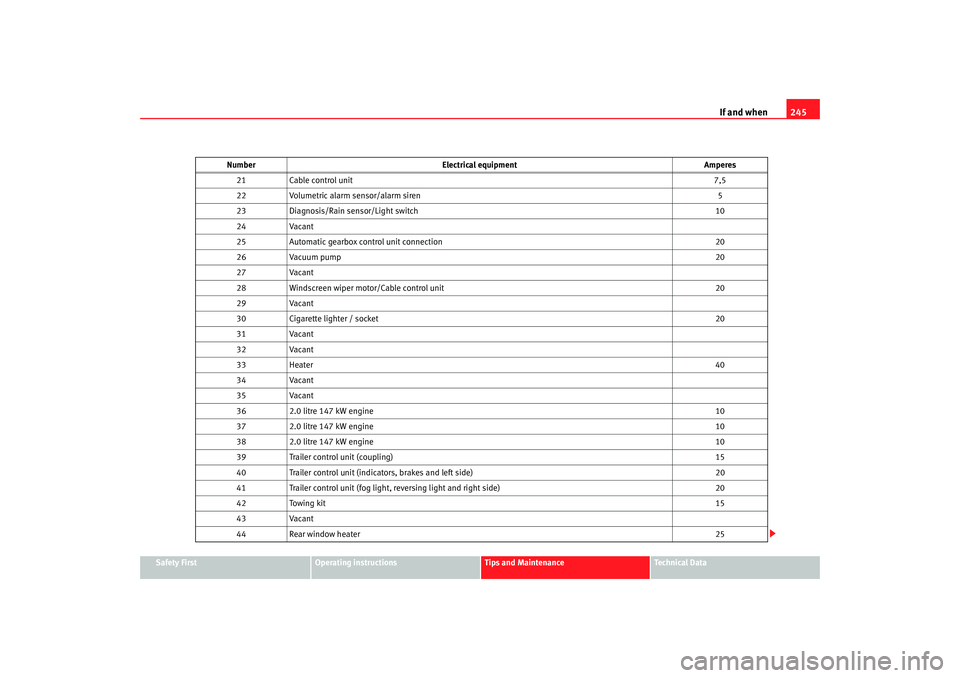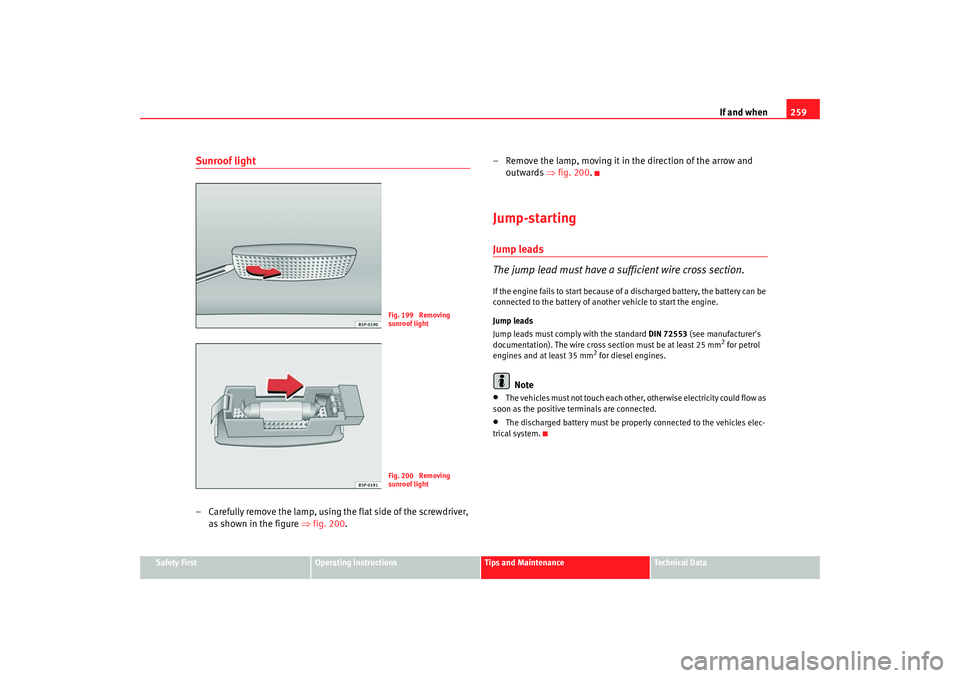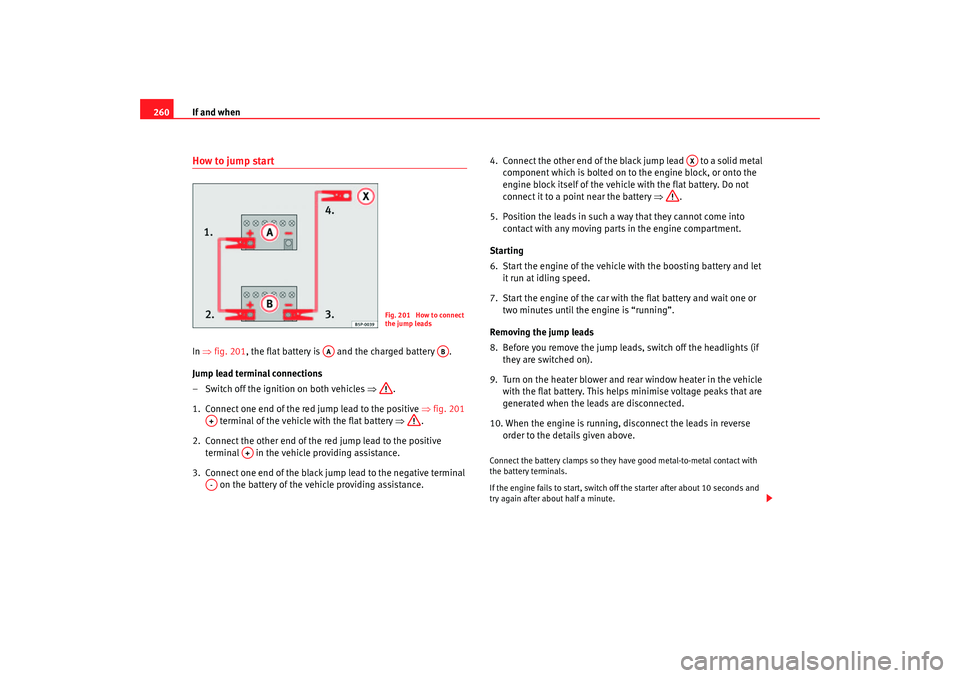engine Seat Toledo 2006 Manual PDF
[x] Cancel search | Manufacturer: SEAT, Model Year: 2006, Model line: Toledo, Model: Seat Toledo 2006Pages: 298, PDF Size: 9.04 MB
Page 244 of 298

If and when
242
– Put the tools back in the luggage compartment.NoteThe compressor should not operate more than 6 minutesFusesChanging a fuse
If a fuse has blown it must be replaced
Fuse cover underneath the steering wheel
– Switch off the ignition and the component concerned.
– Identify the fuse for the failed component ⇒page 244.
– Take the plastic clip from inside the fuse cover, fit it onto the blown fuse and pull the fuse out.
– Replace the blown fuse (which will have a melted metal strip) with a new fuse of the same ampere rating.
Fuse cover in engine compartment
– Switch off the ignition and the component concerned.
– Prise off the fuse cover in the engine compartment by pressing the tabs towards the centre of the cover ⇒fig. 179 .
– Identify the fuse for the failed component ⇒page 244.
Fig. 178 Left side of dash
panel: Fuse box cover
Fig. 179 Fuse box cover
in engine compartment
toledo_angles_0706 Seite 242 Dienstag, 5. September 2006 10:32 10
Page 245 of 298

If and when243
Safety First
Operating instructions
Tips and Maintenance
Te c h n i c a l D a t a
– Take the plastic clip from inside the fuse cover (at left-hand end
of the dash panel), fit it onto the blown fuse and pull the fuse out.
– Replace the blown fuse (which will have a melted metal strip) with a new fuse of the same ampere rating.
– Carefully fit the fuse cover back on to ensure no water can enter the fuse box.The individual electrical circuits are pr otected by fuses. The fuses are located
behind a cover at the left-hand end of the dash panel and on the left-hand
side of the engine compartment.
The electric windows are protected by circuit breakers. These reset automat-
ically after a few seconds when the overload (caused for example by frozen
windows) has been corrected.
Colour coding of fuses
WARNING
Never “repair” damaged fuses and never replace them with fuses with a
higher rating. Failure to comply could re sult in fire. This could also cause
damage to other parts of the electrical system.
Note
•
If a newly replaced fuse blows again after a short time, the electrical
system must be checked by a qualified workshop as soon as possible.
•
If you replace a fuse with a stronger fuse, you could cause damage to
another location in the electrical system.
•
Always keep some spare fuses in the vehicle. These are available from
SEAT dealers.
Colour
Amperes
light brown 5
red 10
blue 15
yellow 20
natural (white) 25
green 30
orange 40
red 50
white 80
blue100
grey 150
violet 200
Colour
Amperes
toledo_angles_0706 Seite 243 Dienstag, 5. September 2006 10:32 10
Page 246 of 298

If and when
244Fuses on left side of dash panelFuses
Number Electrical equipment Amperes
1V aca n t
2V aca n t
3V aca n t
4V aca n t
5V aca n t
6V aca n t
7V aca n t
8V aca n t
9 Airbag 5
10 Vacant
11 Vacant
11 After-sales kit 5
12 Left hand side xenon headlight 10
13 Heating controls/ESP, ASR switch/Reverse gear/Telephone pre-installation 5
14 ABS/ESP control unit/ Engine/ Headlights/ Trailer control unit/ light switch/ Instrument panel 10
15 Headlight control unit/ Heated windscreens/ Instrument lighting/ Diagnosis control unit 10
16 Right hand side xenon headlight 10
17 D2L Engine (2.0 litre 147 kW 4 speed TFSI) 10
18 Vacant
19 Vacant
20 Park Pilot (Parking aid) / Gear selector lever/ ESP control unit 10
toledo_angles_0706 Seite 244 Dienstag, 5. September 2006 10:32 10
Page 247 of 298

If and when245
Safety First
Operating instructions
Tips and Maintenance
Te c h n i c a l D a t a
21
Cable control unit 7,5
22 Volumetric alarm sensor/alarm siren 5
23 Diagnosis/Rain sensor/Light switch 10
24 Vacant
25 Automatic gearbox control unit connection 20
26 Vacuum pump 20
27 Vacant
28 Windscreen wiper motor/Cable control unit 20
29 Vacant
30 Cigarette lighter / socket 20
31 Vacant
32 Vacant
33 Heater 40
34 Vacant
35 Vacant
36 2.0 litre 147 kW engine 10
37 2.0 litre 147 kW engine 10
38 2.0 litre 147 kW engine 10
39 Trailer control unit (coupling) 15
40 Trailer control unit (indicators, brakes and left side) 20
41 Trailer control unit (fog light, reversing light and right side) 20
42 Towing kit 15
43 Vacant
44 Rear window heater 25
Number
Electrical equipment Amperes
toledo_angles_0706 Seite 245 Dienstag, 5. September 2006 10:32 10
Page 248 of 298

If and when
246Some of the electrical items listed in the table are only fitted on certain
models or are optional extras.
Please note that the above list, while corr ect at the time of printing, is subject
to alterations. If discrepancies should occur, please refer to the sticker on the
inside of the fuse cover for the correct information for your model. 45
Front electric windows 30
46 Rear electric windows 30
47 Engine (gauge, fuel relay) 15
48 Convenience controls 20
49 Heating controls 40
50 Heated seats 30
51 Sunroof 20
52 Headlight washer system 20
53 Towing kit 20
54 Taxi (taxi metre power supply) 5
55 Towing kit 20
56 Taxi (transmitter power supply) 15
57 Vacant
58 Central locking control unit 30
Number
Electrical equipment Amperes
toledo_angles_0706 Seite 246 Dienstag, 5. September 2006 10:32 10
Page 249 of 298

If and when247
Safety First
Operating instructions
Tips and Maintenance
Te c h n i c a l D a t a
Fuses layout, engine compartment, left partFuses
Number Electrical equipment Amperes
1 Windscreen wipers 30
2 Steering column 5
3 Cable control unit 5
4A BS 30
5 AQ gearbox 15
6 Instrument panel 5
7 Vacant
8R ad io 15
9 Telephone 5
10 Main relay in the FSI / diesel engine
compartment / injection module supply 5
Main relay in the engine compartment D2L (2.0 FSI 147 kW) 10
11 Vacant
12 Gateway 5
13 Petrol injection module supply
25
Diesel injection module supply 30
14 Coil 20
15 Engine T71 / 20 FSI
5
Pump relay 10
16 ADS pump 30
17 Horn 15
18 Vacant
toledo_angles_0706 Seite 247 Dienstag, 5. September 2006 10:32 10
Page 250 of 298

If and when
248
19 Clean 30
20 Vacant
21 Lambda probe 15
22 Brake pedal, speed sensor 5
23 Engine 1.6, main relay (relay n° 100)
5
T 71 diesel EGR 10
2.0 D2L High-pressure fuel pump 15
24 ARF, change valve 10
25 Right lighting 40
26 Left lighting 40
1.6 SLP engine 40
1.9 TDI Glow plug relay 50
28 KL15 40
29 Electric windows (front and back)
50
Electric windows (front) 30
30 X - relief relay 40
Number
Electrical equipment Amperes
toledo_angles_0706 Seite 248 Dienstag, 5. September 2006 10:32 10
Page 251 of 298

If and when249
Safety First
Operating instructions
Tips and Maintenance
Te c h n i c a l D a t a
Position in engine compartment: side boxFuses
Some of the electrical items listed in the table are only fitted on certain
models or are optional extras.
Please note that the above list, while correct at the time of printing, is subject
to alterations.Bulb changeGeneral notesBefore changing any bulb first turn off the equipment concerned.
Do not touch the bulb glass. Fingerprints vaporise in the heat, causing a
reduction in the bulb life and condensation on the mirror surface, thus
reducing efficiency. A bulb should only be replaced by one of the same type. The type is inscribed
on the bulb, either on the glass part or on the base.
It is highly recommended to keep a box of spare bulbs in the vehicle. At the
very least, the bulbs that most affect road safety should have spares in the
vehicle.
Main headlights
Dipped beam - H7
Main beam - H1
Position - W5W
Turn signals - PY21W
Number
Electrical equipment Amperes
B1 Alternator < 140 W
150
Alternator > 140 W 200
C1 Power steering 80
D1 Multi-terminal voltage supply “30”. Internal fuse box 100
E1 Ventilator > 500 W / Ventilator < 500 W 80/50
F1 PTCs (Supplementary electrical heating using air) 80
G1 PTCs (Supplementary electrical heating using air) 40
H1 Central locking control unit (4F8 with autolock)
toledo_angles_0706 Seite 249 Dienstag, 5. September 2006 10:32 10
Page 261 of 298

If and when259
Safety First
Operating instructions
Tips and Maintenance
Te c h n i c a l D a t a
Sunroof light– Carefully remove the lamp, using the flat side of the screwdriver,
as shown in the figure ⇒fig. 200. – Remove the lamp, moving it in the direction of the arrow and
outwards ⇒fig. 200.
Jump-startingJump leads
The jump lead must have a sufficient wire cross section.If the engine fails to start because of a discharged battery, the battery can be
connected to the battery of another vehicle to start the engine.
Jump leads
Jump leads must comply with the standard DIN 72553 (see manufacturer's
documentation). The wire cross section must be at least 25 mm
2 for petrol
engines and at least 35 mm
2 for diesel engines.
Note
•
The vehicles must not touch each othe r, otherwise electricity could flow as
soon as the positive terminals are connected.
•
The discharged battery must be properly connected to the vehicles elec-
trical system.
Fig. 199 Removing
sunroof lightFig. 200 Removing
sunroof light
toledo_angles_0706 Seite 259 Dienstag, 5. September 2006 10:32 10
Page 262 of 298

If and when
260How to jump startIn ⇒ fig. 201, the flat battery is and the charged battery .
Jump lead terminal connections
– Switch off the ignition on both vehicles ⇒.
1. Connect one end of the red jump lead to the positive ⇒fig. 201
terminal of the vehicle with the flat battery ⇒.
2. Connect the other end of the red jump lead to the positive terminal in the vehicle providing assistance.
3. Connect one end of the black jump lead to the negative terminal on the battery of the vehicle providing assistance. 4. Connect the other end of the black jump lead to a solid metal
component which is bolted on to the engine block, or onto the
engine block itself of the vehicle with the flat battery. Do not
connect it to a point near the battery ⇒.
5. Position the leads in such a way that they cannot come into contact with any moving parts in the engine compartment.
Starting
6. Start the engine of the vehicle with the boosting battery and let it run at idling speed.
7. Start the engine of the car with the flat battery and wait one or two minutes until the engine is “running”.
Removing the jump leads
8. Before you remove the jump leads, switch off the headlights (if they are switched on).
9. Turn on the heater blower and rear window heater in the vehicle with the flat battery. This helps minimise voltage peaks that are
generated when the leads are disconnected.
10. When the engine is running, disconnect the leads in reverse order to the deta ils given above.
Connect the battery clamps so they have good metal-to-metal contact with
the battery terminals.
If the engine fails to start, switch off the starter after about 10 seconds and
try again after about half a minute.
Fig. 201 How to connect
the jump leads
AA
AB
A+
A+
A-
AX
toledo_angles_0706 Seite 260 Dienstag, 5. September 2006 10:32 10